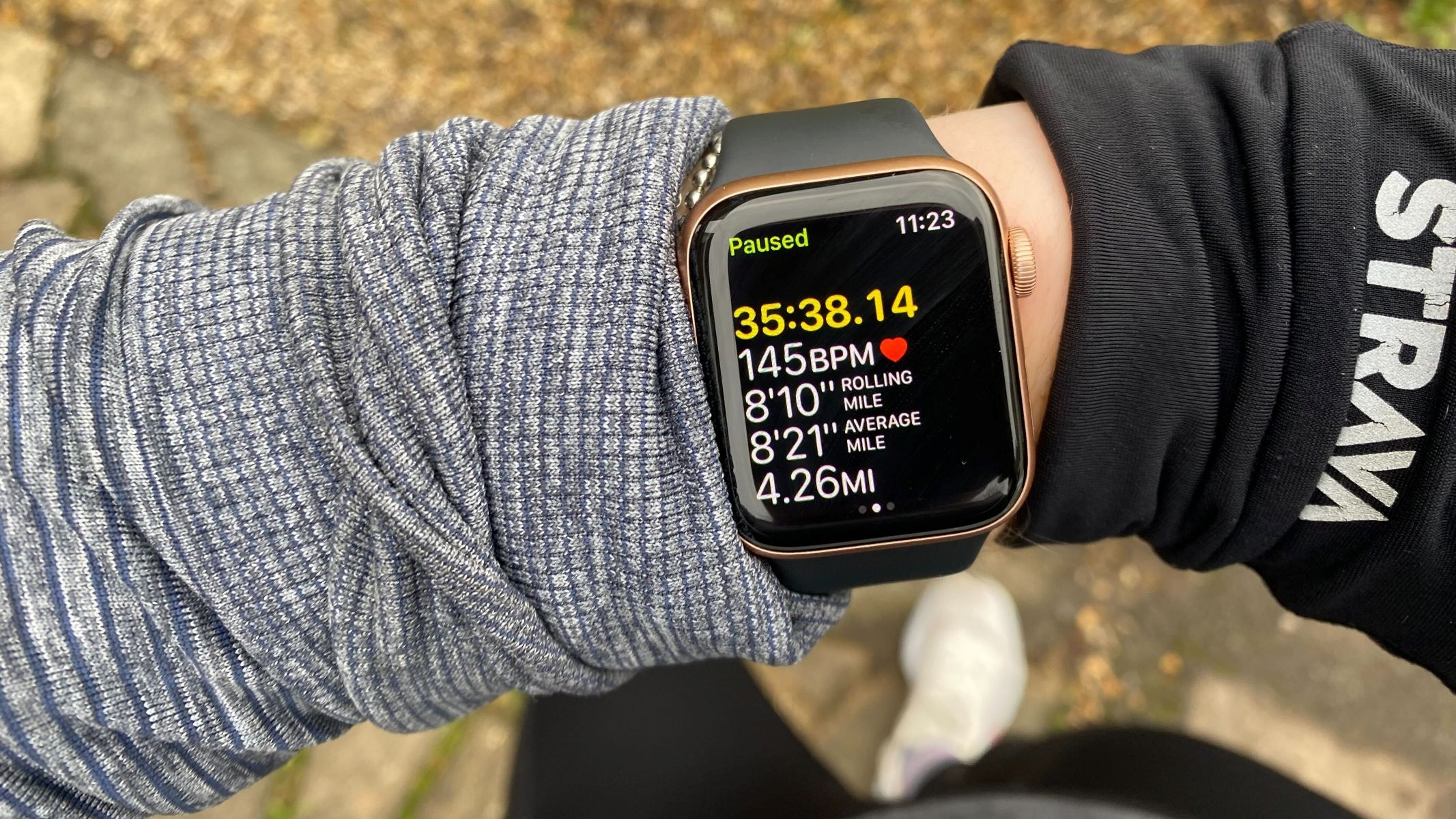Home>Misc>Featured>Which Of The Following Scenarios Best Illustrates Interval Training


Featured
Which Of The Following Scenarios Best Illustrates Interval Training
Modified: May 22, 2024
Learn about the best interval training scenarios featured in this guide and how they can boost your fitness routine. Discover the benefits and techniques for effective interval training.
Introduction
Interval training has become a popular and effective workout method in recent years. Its ability to ramp up intensity and maximize results in a shorter amount of time has captured the attention of fitness enthusiasts and professionals alike. Whether you’re a seasoned athlete or just starting your fitness journey, interval training can be a game-changer in achieving your goals.
So, what exactly is interval training? Simply put, interval training involves alternating periods of high-intensity exercise with periods of lower-intensity recovery or rest. This pattern of alternating intensities challenges your body in a unique way, pushing you to work harder and achieve greater fitness gains.
The benefits of interval training are numerous and varied. First and foremost, it is a fantastic method for improving cardiovascular fitness. The high-intensity intervals elevate your heart rate, improving blood circulation and overall cardiovascular health. Interval training also helps increase the efficiency of your aerobic system, allowing you to sustain higher levels of intensity for longer durations.
Additionally, interval training is known to be an effective way to burn calories and lose weight. The intense bursts of exercise during the high-intensity intervals help to boost your metabolism, causing your body to continue burning calories even after you’ve finished your workout. This calorie-burning effect, known as excess post-exercise oxygen consumption (EPOC), can help to accelerate weight loss and improve body composition.
Beyond cardiovascular health and weight loss, interval training has been found to improve athletic performance by enhancing speed, power, and endurance. The high-intensity intervals mimic the demands of sports and activities that require quick bursts of energy, making it an excellent training method for athletes in a variety of disciplines.
Moreover, interval training can be adapted to suit various fitness levels and preferences. Whether you prefer running, cycling, swimming, or bodyweight exercises, interval training can be customized to fit your specific goals and needs. This versatility and flexibility make it an accessible and enjoyable training method for people of all fitness levels.
In the following scenarios, we will delve into different examples of how interval training can be incorporated into various workouts. Each scenario highlights a different type of interval training and showcases how it can be applied in different fitness settings. Let’s explore these scenarios to gain a better understanding of how interval training can transform your workouts and help you achieve your fitness goals.
What is Interval Training?
Interval training is a workout method that involves alternating periods of high-intensity exercise with periods of lower-intensity recovery or rest. This training technique is designed to challenge your body and push it to its limits, resulting in improved fitness and performance.
The structure of interval training is what sets it apart from traditional continuous exercise. Instead of maintaining a steady intensity throughout the entire workout, you push yourself to your maximum effort during the high-intensity intervals and then allow your body to recover during the lower-intensity or rest periods.
The duration and intensity of the intervals can be customized to fit your fitness level and goals. For example, you might perform short bursts of high-intensity exercise, such as sprinting for 30 seconds, followed by a period of active recovery like walking for 1 minute. This pattern of alternating intensities can be repeated for a set number of rounds or for a specific time period.
One of the key benefits of interval training is its ability to improve cardiovascular fitness. The intense bursts of exercise during the high-intensity intervals elevate your heart rate and challenge your cardiovascular system. Over time, this leads to increased cardiovascular capacity, allowing you to endure longer and more intense workouts.
In addition to cardiovascular benefits, interval training is also effective for burning calories and losing weight. The high-intensity intervals activate your aerobic and anaerobic energy systems, resulting in a higher calorie burn during and after the workout. This calorie-burning effect, known as excess post-exercise oxygen consumption (EPOC), can help boost your metabolism and contribute to weight loss.
Interval training is not limited to a specific type of exercise. It can be incorporated into various activities such as running, cycling, swimming, or even bodyweight exercises. This versatility allows you to choose exercises that you enjoy and that align with your fitness goals.
When implementing interval training, it’s important to gradually increase the intensity and duration of the high-intensity intervals to avoid injury and overexertion. It is also crucial to listen to your body and adjust the intensity and duration of the intervals based on your fitness level and recovery ability.
To sum up, interval training is a highly effective workout method that can improve cardiovascular fitness, burn calories, and enhance performance. Through the manipulation of intensity and rest periods, interval training offers a challenging and adaptable approach to fitness that can be customized to meet individual needs and goals.
Benefits of Interval Training
Interval training offers a multitude of benefits that make it a popular and effective workout method for individuals of all fitness levels. Here are some key advantages of incorporating interval training into your fitness routine:
- Improved cardiovascular fitness: Interval training challenges your cardiovascular system by elevating your heart rate during the high-intensity intervals. This leads to improved cardiovascular capacity, allowing you to endure longer and more intense workouts.
- Efficient calorie burning: The high-intensity intervals in interval training activate both your aerobic and anaerobic energy systems, resulting in increased calorie burn during and after the workout. This can help expedite weight loss and improve body composition.
- Enhanced endurance: By pushing yourself to your limits during the high-intensity intervals and allowing for recovery during the rest periods, you gradually increase your endurance levels. This allows you to sustain higher levels of intensity for longer durations.
- Time-saving: Interval training allows you to achieve a significant calorie burn and cardiovascular stimulus in a shorter amount of time compared to traditional continuous exercise. This makes it a time-efficient workout option for individuals with busy schedules.
- Variety and enjoyment: The ability to customize interval training to suit your preferences and fitness goals provides variety and keeps your workouts interesting. You can choose different exercises and interval durations to keep your routine fresh and enjoyable.
- Adaptability: Interval training can be adjusted to accommodate various fitness levels. Beginners can start with shorter, less intense intervals and gradually progress as their fitness improves. Advanced exercisers can challenge themselves with longer, more intense intervals.
- Improved athletic performance: Interval training mimics the demands of sports and activities that require quick bursts of energy. By incorporating interval training into your routine, you can enhance your speed, power, and overall athletic performance.
- Mental benefits: Interval training can provide a mental challenge and a sense of accomplishment. Pushing yourself during the high-intensity intervals and pushing through fatigue can help improve mental resilience and discipline.
Overall, interval training offers a range of benefits that go beyond cardiovascular fitness and calorie burning. Its versatility, time efficiency, and adaptability make it an excellent choice for individuals looking to maximize their workouts and achieve their fitness goals.
Scenario 1: Sprint Interval Training on a Treadmill
In this scenario, we’ll explore how sprint interval training can be incorporated into a treadmill workout. Sprinting is an excellent way to engage multiple muscle groups, burn calories, and improve cardiovascular fitness.
To begin, warm up by walking or jogging at a moderate pace for 5 minutes. Once you’re warmed up, increase the treadmill speed to a challenging sprinting pace. Sprint at this maximum effort for 30 seconds to 1 minute, pushing yourself to your limits.
After the sprint interval, reduce the treadmill speed to a slow jog or walk for 1-2 minutes to allow for recovery. Catch your breath and prepare for the next sprint interval. Repeat this pattern of sprinting and recovery for a total of 10-15 rounds.
During the sprint intervals, focus on maintaining proper running form, driving your knees up, and pumping your arms. Engage your core muscles for stability and power. Pay attention to your breathing, taking deep breaths in through your nose and exhaling forcefully through your mouth.
As you progress, you can increase the duration of the sprint intervals or the speed at which you sprint. Remember to listen to your body and adjust the intensity based on your fitness level and comfort. You can also incorporate incline intervals by increasing the treadmill incline during the sprint segments.
Once you’ve completed the sprint intervals, finish the workout with a 5-minute cooldown by gradually reducing the treadmill speed and allowing your heart rate to return to normal. Stretching your lower body muscles, such as your quadriceps, hamstrings, and calves, is also recommended to prevent muscle tightness and promote flexibility.
This sprint interval training on a treadmill is an efficient and challenging workout that can help improve your speed, cardiovascular fitness, and calorie burn. It is a great option for individuals who prefer indoor workouts or want to avoid outdoor terrain.
Remember to start at your own fitness level and gradually increase the intensity and duration of the sprint intervals as you become more comfortable and conditioned. It’s important to listen to your body, stay hydrated, and fuel yourself with proper nutrition to support your workouts.
Next, let’s explore another interval training scenario that incorporates different exercises and equipment.
Scenario 2: Circuit Training with Interval Timers
In this scenario, we’ll explore how to incorporate interval training into a circuit training workout using interval timers. Circuit training is a versatile and efficient way to work multiple muscle groups and improve both strength and cardiovascular fitness.
To begin, set up a circuit consisting of 5-6 different exercises targeting different muscle groups. Some examples include squats, push-ups, lunges, overhead presses, planks, and kettlebell swings. Arrange the exercises in a way that allows you to transition smoothly between them.
Set your interval timer with two different time intervals: one for the work period and one for the rest period. A common ratio is 30 seconds of work followed by 15 seconds of rest, but you can adjust the intervals based on your fitness level and preferences.
Start the interval timer and perform each exercise at a high intensity for the designated work time. Focus on maintaining proper form and engaging the targeted muscles. Use weights or resistance bands as needed to increase the challenge. Push yourself to your limits during the work period.
When the rest period begins, use it to transition to the next exercise in the circuit. Take a few deep breaths and prepare yourself mentally for the next round of intense exercise. The rest period allows for recovery and helps maintain the intensity throughout the workout.
Repeat the circuit for a specific number of rounds or a set duration, such as 20 minutes. If you have more time or energy, you can increase the number of rounds or extend the duration of the workout.
During the circuit training, it’s important to listen to your body and adjust the intensity and difficulty of the exercises as needed. You can modify the workout by using lighter weights, performing modifications of the exercises, or reducing the number of repetitions.
As you become more comfortable with the circuit training, challenge yourself by increasing the intensity, using heavier weights, or incorporating more challenging variations of the exercises. Always prioritize safety and proper form over pushing yourself to the extreme.
Remember to cool down and stretch your muscles after completing the circuit training. This can help to prevent muscle soreness and improve flexibility. Hydrate yourself adequately before, during, and after the workout to stay energized and maintain optimal performance.
Circuit training with interval timers is an effective way to combine strength training and cardiovascular conditioning. The fast-paced nature of the workout keeps you engaged and maximizes calorie burn while improving muscular strength and endurance.
Now that we’ve explored circuit training, let’s move on to another scenario focusing on a different approach to interval training.
Scenario 3: High-Intensity Interval Training (HIIT) in a Group Fitness Class
In this scenario, we’ll delve into the world of high-intensity interval training (HIIT) in a group fitness class setting. HIIT is a popular and intense form of interval training that can deliver incredible results in a short amount of time.
Joining a group fitness class is a great way to stay motivated and push your limits alongside others who share similar fitness goals. Group HIIT classes are typically led by an instructor and involve a combination of cardiovascular exercises, bodyweight movements, and strength exercises.
The class begins with a dynamic warm-up to prepare your body for the intense workout ahead. This usually includes dynamic stretches, light cardio exercises, and mobility drills to increase your heart rate and loosen up your muscles.
Once warmed up, the instructor will guide you through a series of high-intensity intervals, often lasting 30-60 seconds each, followed by short periods of rest or active recovery. The exercises can vary from burpees, jumping jacks, and mountain climbers to kettlebell swings, squat jumps, and medicine ball slams.
The instructor will provide verbal cues to ensure proper form and technique during each exercise. It’s important to focus on maintaining good form while pushing yourself to your limits during the high-intensity intervals. Remember to listen to your body and modify any exercises that are too challenging or uncomfortable.
The class is designed to keep your heart rate elevated throughout the duration, maximizing calorie burn and cardiovascular benefits. The intensity of the workout, combined with the energy of the group and motivating music, creates a challenging and exhilarating environment.
HIIT classes often incorporate different workout formats, such as Tabata or AMRAP (as many rounds as possible). These formats add variety and challenge to the workout, pushing you to give your all during each interval.
As the class progresses, you may target different muscle groups or switch between cardio and strength exercises. This variety keeps the workout engaging and prevents boredom, ensuring that you continue to push yourself and achieve fitness gains.
At the end of the class, a cool-down period is included to gradually reduce your heart rate and stretch your muscles. This helps to promote recovery and prevent muscle soreness.
Group HIIT classes offer a supportive and motivating environment, allowing you to push yourself further than you might on your own. The energy of the group, the guidance of the instructor, and the structured format of the class can lead to enhanced results and a sense of accomplishment.
If you’re interested in high-intensity interval training and thrive in a group setting, a group HIIT class might be the perfect fit for you. It’s a challenging and fun way to incorporate interval training into your fitness routine.
Now that we’ve explored group HIIT classes, let’s move on to another scenario that focuses on a specific form of interval training using bodyweight exercises.
Scenario 4: Tabata Training with Bodyweight Exercises
In this scenario, we’ll explore Tabata training, a form of high-intensity interval training (HIIT) that involves short bursts of intense exercise followed by brief periods of rest. Tabata training is known for its efficiency and ability to push your limits in a short amount of time.
Tabata training is typically structured into intervals of 20 seconds of intense exercise followed by 10 seconds of rest, repeated for a total of 4 minutes. This 4-minute block is called a Tabata set. The exercises chosen for Tabata training are often bodyweight exercises that target multiple muscle groups.
Start by selecting four bodyweight exercises that you are comfortable performing with good form. Examples include squats, push-ups, burpees, mountain climbers, jumping lunges, and plank variations. Arrange the exercises in a circuit format, performing each exercise back-to-back for 20 seconds before moving on to the next.
Once you are ready to begin, set a timer for four minutes, and start with the first exercise. Give it your all during the 20 seconds of work, performing as many repetitions as possible with proper form and technique.
When the 20 seconds are up, take a quick 10-second rest before moving on to the next exercise in the circuit. Continue this pattern for all four exercises, completing one full Tabata set.
Between each Tabata set, take a longer rest period of 1-2 minutes to allow for a brief recovery. Use this time to catch your breath, hydrate, and mentally prepare for the next set. Repeat the Tabata sets for a total of 3-4 rounds.
Throughout the Tabata sets, it’s important to maintain proper form and technique to prevent injury. Focus on engaging the targeted muscles and controlling your movements. Modify any exercises that are too challenging or not suitable for your fitness level.
Tabata training with bodyweight exercises is a fast-paced and impactful workout that can be done anywhere, as it requires no equipment. It challenges your muscular endurance, cardiovascular fitness, and calorie burn.
If you’re short on time but want a highly effective workout, Tabata training with bodyweight exercises is an excellent option. It allows you to push your limits, improve your fitness, and achieve a challenging workout in a short amount of time.
Now that we’ve explored Tabata training with bodyweight exercises, let’s move on to our final scenario focusing on interval training in the pool.
Scenario 5: Interval Swimming Workouts
In this scenario, we’ll explore how interval training can be incorporated into swimming workouts, offering a low-impact and highly effective way to improve cardiovascular fitness and muscular strength.
Swimming is a fantastic full-body workout that engages multiple muscle groups while providing resistance and cardiovascular benefits. By incorporating interval training into your swimming workouts, you can maximize your time in the pool and achieve greater results.
Begin by warming up with a few laps of easy swimming to prepare your body for the workout. Once warmed up, you can structure your interval swim workout in various ways, depending on your fitness level and goals.
One approach is to alternate between different stroke styles. For example, you can swim freestyle at a high intensity for a set distance or time, followed by an easy recovery swim using a different stroke style like backstroke or breaststroke. Repeat this pattern for several rounds, gradually increasing the intensity or distance of the high-intensity intervals.
Another approach is to focus on specific swim drills or strokes during the interval training. This allows you to work on technique and improve efficiency while still incorporating intervals. For instance, you can swim a specified number of laps using the butterfly stroke at a maximum effort, followed by a recovery swim using a different stroke or drill.
You can also use a poolside timer or interval timer app to set specific intervals for your swim workout. Set a challenging time for your high-intensity swim, such as 30 seconds, and then allow yourself a brief rest period before repeating the interval. Aim to complete several rounds of these intervals, focusing on maintaining proper form and technique throughout.
During the high-intensity intervals, it’s essential to maintain a strong kick, engage your core, and use proper breathing techniques. Push yourself to swim at near-maximum effort, challenging your cardiovascular system and muscular strength.
As with any exercise, it’s important to listen to your body and adjust the intensity and duration of the intervals based on your fitness level and comfort. Gradually increase the intensity and distance of the intervals as you become more conditioned and proficient in the water.
Finish your swim workout with a cool-down period, gradually reducing your intensity and swimming at an easy pace for a few laps. This helps to bring your heart rate down, relax your muscles, and promote recovery.
Swimming interval workouts provide a unique and refreshing way to incorporate high-intensity interval training into your fitness routine. The buoyancy of water minimizes impact on joints while still providing an intense workout that improves cardiovascular fitness and strengthens muscles.
Now that we’ve explored interval swimming workouts, you have a variety of scenarios to choose from to incorporate interval training into your fitness routine. Feel free to mix and match these scenarios or explore other interval training methods to find what works best for you.
Conclusion
Interval training is a highly effective and versatile workout method that can be tailored to fit a variety of fitness goals and preferences. By incorporating intervals of high-intensity exercise followed by periods of rest or lower intensity, you can maximize your workouts and achieve greater results in less time.
The benefits of interval training are numerous. It improves cardiovascular fitness, burns calories, enhances endurance, and can even improve athletic performance. Whether you choose to engage in sprint interval training on a treadmill, circuit training with interval timers, high-intensity interval training (HIIT) in a group fitness class, Tabata training with bodyweight exercises, or interval swimming workouts, you can experience the multitude of benefits that intervals provide.
It’s important to approach interval training with caution and gradually increase the intensity and duration of the intervals as you become more conditioned. Listening to your body, using proper form, and allowing for adequate rest and recovery are key to preventing injuries and achieving long-term success.
Remember, interval training is not limited to any specific exercise or equipment. It can be adapted to suit your fitness level, preferences, and available resources. The key is to push yourself during the high-intensity intervals, focusing on quality and effort, while also allowing yourself sufficient rest and recovery to maintain safety and prevent burnout.
Incorporating interval training into your fitness routine can add variety, intensity, and efficiency to your workouts. It keeps your body and mind challenged, prevents plateaus, and leads to exciting progress and results. Whether you’re a beginner or an experienced athlete, interval training can take your fitness journey to new heights.
So, get creative, choose the interval training scenario that resonates with you, and start reaping the rewards of this powerful workout method. Embrace the challenge, stay consistent, and celebrate the transformation that interval training can bring to your overall health and fitness.









